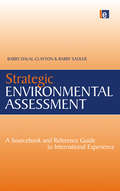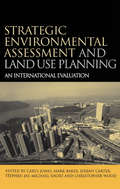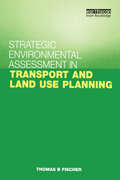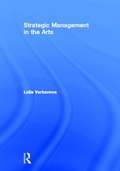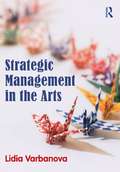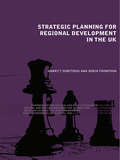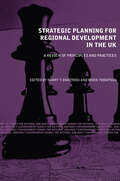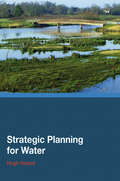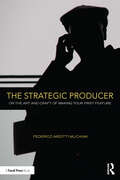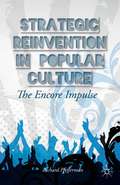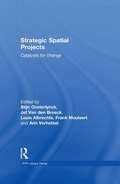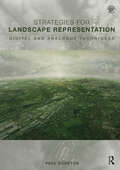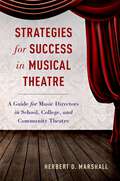- Table View
- List View
Strategic Environmental Assessment: A Sourcebook and Reference Guide to International Experience
by Barry Sadler Barry Dalal-ClaytonThis unique sourcebook provides a global, state-of-the-art review of the rapidly evolving field of strategic environmental assessment (SEA) that is intended to serve as a baseline for the work of an OECD Task Team on SEA and a UNEP initiative on integrated planning and assessment. It describes trends in application and experience in different contexts worldwide, providing in-depth coverage of the status of SEA systems, and practice in developed, transitional and developing countries by a range of development agencies. The book draws on a large body of published and unpublished material, and contributions from a wide range of individual experts, organizations and agencies. It provides an unparalleled and invaluable understanding of the emerging scope and potential of SEA and describes how, when and where it is being used. The sourcebook includes a probing review of concepts, terminology, approaches and tools of SEA, and a comparative analysis of the different types of existing SEA systems. The volume also contains many case examples illustrating SEA practice in different countries and contexts, a full set of references and a number of appendices containing source materials.
Strategic Environmental Assessment and Land Use Planning: An International Evaluation
by Michael Short Mark Baker Jeremy Carter Stephen Jay Carys Jones'A wonderfully international and up-to-date perspective on strategic environmental assessment of land use plans by leading experts in the field. Strategic Environmental Assessment and Land Use Planning covers not only how much such SEAs are carried out and in what context, but whether they are effective and why. It provides invaluable insights for practitioners and researchers in this rapidy evolving field' Riki Therivel, author of Strategic Environmental Assessment in Action Strategic Environmental Assessment and Land Use Planning provides an authoritative, international evaluation of the SEA of land use plans. The editors place the SEA of land use plans in context, and uniquely qualified contributors then evaluate systems in Canada, Denmark, Germany, Hong Kong, Hungary, Ireland, The Netherlands, New Zealand, Portugal, South Africa, Sweden, the United Kingdom, the United States and the World Bank. These chapters provide a description of the context in each country, a case study of the use of SEA in land use planning and an evaluation of each SEA system against a set of generic criteria specially designed to anlayse different aspects of SEA. The contributors critically review each SEA system, SEA process and SEA outcome, and conclude by summarizing their findings. The editors draw the various national perspectives together in a final chapter and derive widely applicable conclusions about SEA and land use planning. This book is a core text for all students in environmental assessment, land use planning, environmental science, environmental management, development studies, geography, landscape design and law and engineering. It is also essential reading for all governments and environmental regulators, academics, researchers and environmental and planning consultants worldwide who are involvedin SEA research, practice and training.
Strategic Environmental Assessment and Land Use Planning: An International Evaluation
by Michael Short Mark Baker Jeremy Carter Stephen Jay Carys Jones'A wonderfully international and up-to-date perspective on strategic environmental assessment of land use plans by leading experts in the field. Strategic Environmental Assessment and Land Use Planning covers not only how much such SEAs are carried out and in what context, but whether they are effective and why. It provides invaluable insights for practitioners and researchers in this rapidy evolving field' Riki Therivel, author of Strategic Environmental Assessment in Action Strategic Environmental Assessment and Land Use Planning provides an authoritative, international evaluation of the SEA of land use plans. The editors place the SEA of land use plans in context, and uniquely qualified contributors then evaluate systems in Canada, Denmark, Germany, Hong Kong, Hungary, Ireland, The Netherlands, New Zealand, Portugal, South Africa, Sweden, the United Kingdom, the United States and the World Bank. These chapters provide a description of the context in each country, a case study of the use of SEA in land use planning and an evaluation of each SEA system against a set of generic criteria specially designed to anlayse different aspects of SEA. The contributors critically review each SEA system, SEA process and SEA outcome, and conclude by summarizing their findings. The editors draw the various national perspectives together in a final chapter and derive widely applicable conclusions about SEA and land use planning. This book is a core text for all students in environmental assessment, land use planning, environmental science, environmental management, development studies, geography, landscape design and law and engineering. It is also essential reading for all governments and environmental regulators, academics, researchers and environmental and planning consultants worldwide who are involvedin SEA research, practice and training.
Strategic Environmental Assessment in Transport and Land Use Planning
by Thomas B. FischerAssessing the full scale of environmental impacts is essential for effective planning of transport and land use. This is an analysis of transport and land-use planning using strategic environmental assessment (SEA). It establishes the effectiveness of SEA through comparative studies of practice in three countries: Britain, the Netherlands and Germany. The author shows that use of SEA is widespread but far from systematic. He demonstrates the advantages of adopting a systematic application of a comprehensive form of SEA derived from all the major current approaches. Only once this approach is fully understood and systematically applied will all the full benefits be achieved and environmental impacts be minimalized.
Strategic Environmental Assessment in Transport and Land Use Planning
by Thomas B. FischerAssessing the full scale of environmental impacts is essential for effective planning of transport and land use. This is an analysis of transport and land-use planning using strategic environmental assessment (SEA). It establishes the effectiveness of SEA through comparative studies of practice in three countries: Britain, the Netherlands and Germany. The author shows that use of SEA is widespread but far from systematic. He demonstrates the advantages of adopting a systematic application of a comprehensive form of SEA derived from all the major current approaches. Only once this approach is fully understood and systematically applied will all the full benefits be achieved and environmental impacts be minimalized.
Strategic Management in the Arts
by Lidia VarbanovaStrategic Management in the Arts looks at the unique characteristics of organisations in the arts and culture sector and shows readers how to tailor a strategic plan to help these diverse organizations meet their objectives. Strategic management is an essential element that drives an organisation's success, yet many cultural organizations have yet to apply strategic thinking and entrepreneurial actions within the management function. Varbanova reviews the existing theories and models of strategic management and then relates these specifically to cultural organisations. Also included are sections on entrepreneurship and innovations in the arts, considering the concept of a 'learning organisation' - an organisation able to adapt its strategy within a constantly changing, complex environment. The book is structured to walk the reader through each element of the strategic plan systematically. With a fresh approach, key questions, examples, international cases to connect theory with practice and suggestions for further reading, this book is designed to accompany classes on strategic planning, cultural management or arts management. Strategic Management in the Arts looks at the unique characteristics of organisations in the arts and culture sector and shows readers how to tailor a strategic plan to help these diverse organizations meet their objectives. Strategic management is an essential element that drives an organisation's success, yet many cultural organizations have yet to apply strategic thinking and entrepreneurial actions within the management function. Varbanova reviews the existing theories and models of strategic management and then relates these specifically to cultural organisations. Also included are sections on entrepreneurship and innovations in the arts, considering the concept of a 'learning organisation' - an organisation able to adapt its strategy within a constantly changing, complex environment. The book is structured to walk the reader through each element of the strategic plan systematically. With a fresh approach, key questions, examples, international cases to connect theory with practice and suggestions for further reading, this book is designed to accompany classes on strategic planning, cultural management or arts management.
Strategic Management in the Arts
by Lidia VarbanovaStrategic Management in the Arts looks at the unique characteristics of organisations in the arts and culture sector and shows readers how to tailor a strategic plan to help these diverse organizations meet their objectives. Strategic management is an essential element that drives an organisation’s success, yet many cultural organizations have yet to apply strategic thinking and entrepreneurial actions within the management function. Varbanova reviews the existing theories and models of strategic management and then relates these specifically to cultural organisations. Also included are sections on entrepreneurship and innovations in the arts, considering the concept of a ‘learning organisation’ – an organisation able to adapt its strategy within a constantly changing, complex environment. The book is structured to walk the reader through each element of the strategic plan systematically. With a fresh approach, key questions, examples, international cases to connect theory with practice and suggestions for further reading, this book is designed to accompany classes on strategic planning, cultural management or arts management.
Strategic Management in the Arts
by Lidia VarbanovaStrategic Management in the Arts looks at the unique characteristics of organisations in the arts and culture sector and shows readers how to tailor a strategic plan to help these diverse organizations meet their objectives. Strategic management is an essential element that drives an organisation’s success, yet many cultural organizations have yet to apply strategic thinking and entrepreneurial actions within the management function. Varbanova reviews the existing theories and models of strategic management and then relates these specifically to cultural organisations. Also included are sections on entrepreneurship and innovations in the arts, considering the concept of a ‘learning organisation’ – an organisation able to adapt its strategy within a constantly changing, complex environment. The book is structured to walk the reader through each element of the strategic plan systematically. With a fresh approach, key questions, examples, international cases to connect theory with practice and suggestions for further reading, this book is designed to accompany classes on strategic planning, cultural management or arts management.
Strategic Management in the Arts (PDF)
by Lidia VarbanovaStrategic Management in the Arts looks at the unique characteristics of organisations in the arts and culture sector and shows readers how to tailor a strategic plan to help these diverse organizations meet their objectives. Strategic management is an essential element that drives an organisation's success, yet many cultural organizations have yet to apply strategic thinking and entrepreneurial actions within the management function. Varbanova reviews the existing theories and models of strategic management and then relates these specifically to cultural organisations. Also included are sections on entrepreneurship and innovations in the arts, considering the concept of a 'learning organisation' - an organisation able to adapt its strategy within a constantly changing, complex environment. The book is structured to walk the reader through each element of the strategic plan systematically. With a fresh approach, key questions, examples, international cases to connect theory with practice and suggestions for further reading, this book is designed to accompany classes on strategic planning, cultural management or arts management. Strategic Management in the Arts looks at the unique characteristics of organisations in the arts and culture sector and shows readers how to tailor a strategic plan to help these diverse organizations meet their objectives. Strategic management is an essential element that drives an organisation's success, yet many cultural organizations have yet to apply strategic thinking and entrepreneurial actions within the management function. Varbanova reviews the existing theories and models of strategic management and then relates these specifically to cultural organisations. Also included are sections on entrepreneurship and innovations in the arts, considering the concept of a 'learning organisation' - an organisation able to adapt its strategy within a constantly changing, complex environment. The book is structured to walk the reader through each element of the strategic plan systematically. With a fresh approach, key questions, examples, international cases to connect theory with practice and suggestions for further reading, this book is designed to accompany classes on strategic planning, cultural management or arts management.
Strategic Management of Built Facilities
by Craig Langston Rima Lauge-KristensenThe effective management of facilities can significantly improve business productivity. In this textbook the authors provide an overview of facility economics and outline the way in which businesses and facility managers can get better value from their physical assets.Students on facilities management and property related degrees will find this an invaluable introduction.
Strategic Management of Built Facilities
by Craig Langston Rima Lauge-KristensenThe effective management of facilities can significantly improve business productivity. In this textbook the authors provide an overview of facility economics and outline the way in which businesses and facility managers can get better value from their physical assets.Students on facilities management and property related degrees will find this an invaluable introduction.
Strategic Planning for Regional Development in the UK (Natural and Built Environment Series)
by Harry T. Dimitriou Robin ThompsonWith contributions from leading academics and practitioners, Strategic Planning for Regional Development in the UK is the most up-to-date treatment of a fast-changing subject. The book discusses: The evolution of regional planning in the UK and the strategic thinking involved The spatial implications of regional economic development policies The methods and techniques needed for the implementation of strategic planning for regional development How strategic planning for regional development is currently put into practice in three UK regions with different priorities. Strategic Planning for Regional Development in the UK is essential reading for students and academics working within strategic and regional planning and provides policy makers and practitioners with a comprehensive and thought provoking introduction to this critically important emerging field.
Strategic Planning for Regional Development in the UK (Natural and Built Environment Series)
by Harry T. Dimitriou Robin ThompsonWith contributions from leading academics and practitioners, Strategic Planning for Regional Development in the UK is the most up-to-date treatment of a fast-changing subject. The book discusses: The evolution of regional planning in the UK and the strategic thinking involved The spatial implications of regional economic development policies The methods and techniques needed for the implementation of strategic planning for regional development How strategic planning for regional development is currently put into practice in three UK regions with different priorities. Strategic Planning for Regional Development in the UK is essential reading for students and academics working within strategic and regional planning and provides policy makers and practitioners with a comprehensive and thought provoking introduction to this critically important emerging field.
Strategic Planning for Water
by Hugh HowesStrategic Planning for Water examines the neglected relationship between planning for water and spatial planning. It provides the background to sustainable water management and assistance to spatial planners in understanding the complex water environment. This extremely topical book examines the challenges of:how to ensure that water supplies are a
Strategic Planning for Water
by Hugh HowesStrategic Planning for Water examines the neglected relationship between planning for water and spatial planning. It provides the background to sustainable water management and assistance to spatial planners in understanding the complex water environment. This extremely topical book examines the challenges of:how to ensure that water supplies are a
The Strategic Producer: On the Art and Craft of Making Your First Feature
by Federico Arditti MuchnikToday’s technologies and economic models won’t settle for a conventional approach to filmmaking. The Strategic Producer: On the Art and Craft of Making Your First Feature combines history, technology, aesthetics, data, decision-making strategies, and time-tested methods into a powerful new approach to producing. An ideal text for aspiring filmmakers, The Strategic Producer orients the reader’s mind-set towards self-empowerment by sharing essential and timeless techniques producers need to get the job done while also embracing the constantly evolving production landscape. - Written in clear, succinct, and non-technical prose. - Includes six sidebar in depth interviews with industry professionals providing additional perspectives. - Clearly presented line drawings help readers quickly understand complex ideas like production timelines, story structure, and business models. - Includes samples from key documents such as script pages, budgets, shooting schedules, and business plans for potential investors.
The Strategic Producer: On the Art and Craft of Making Your First Feature
by Federico Arditti MuchnikToday’s technologies and economic models won’t settle for a conventional approach to filmmaking. The Strategic Producer: On the Art and Craft of Making Your First Feature combines history, technology, aesthetics, data, decision-making strategies, and time-tested methods into a powerful new approach to producing. An ideal text for aspiring filmmakers, The Strategic Producer orients the reader’s mind-set towards self-empowerment by sharing essential and timeless techniques producers need to get the job done while also embracing the constantly evolving production landscape. - Written in clear, succinct, and non-technical prose. - Includes six sidebar in depth interviews with industry professionals providing additional perspectives. - Clearly presented line drawings help readers quickly understand complex ideas like production timelines, story structure, and business models. - Includes samples from key documents such as script pages, budgets, shooting schedules, and business plans for potential investors.
Strategic Reinvention in Popular Culture: The Encore Impulse
by Richard PfeffermanNot all original works invoke the encore impulse in their audiences. Those that do generally spawn replications - sequels, spin-offs, or re-makes. This book presents a theory of why some replications succeed and others fail across genres and media.
Strategic Spatial Projects: Catalysts for Change (RTPI Library Series)
by Stijn Oosterlynck Jef Van Den Broeck Louis Albrechts Frank Moulaert Ann VerhetselStrategic Spatial Projects presents four years of case study research and theoretical discussions on strategic spatial projects in Europe and North America. It takes the position that planning is not well equipped to take on its current challenges if it is considered as only a regulatory and administrative activity. There is an urgent need to develop a mode of planning that aims to innovate in spatial as well as social terms. This timely, important book is for spatial planning, urban design and community development and policy studies courses. For academics, researchers and students in planning, urban design, urban studies, human and economic geography, public administration and policy studies.
Strategic Spatial Projects: Catalysts for Change (RTPI Library Series)
by Stijn Oosterlynck Jef Van Den Broeck Louis Albrechts Frank Moulaert Ann VerhetselStrategic Spatial Projects presents four years of case study research and theoretical discussions on strategic spatial projects in Europe and North America. It takes the position that planning is not well equipped to take on its current challenges if it is considered as only a regulatory and administrative activity. There is an urgent need to develop a mode of planning that aims to innovate in spatial as well as social terms. This timely, important book is for spatial planning, urban design and community development and policy studies courses. For academics, researchers and students in planning, urban design, urban studies, human and economic geography, public administration and policy studies.
Strategien der Einverleibung: Die Rezeption der Antropofagia in der zeitgenössischen brasilianischen Kunst (Image #166)
by Irina Hiebert GrunDas im brasilianischen Modernismus der 1920er Jahre entwickelte Konzept der Antropofagia beinhaltet die kulturelle Einverleibung des Fremden. Es theoretisiert ein hybrides Kunstverständnis, das hegemonial geprägte Dichotomien überwindet. Irina Hiebert Grun analysiert zeitgenössische Werke von Ricardo Basbaum, Anna Maria Maiolino, Cildo Meireles, Ernesto Neto und Adriana Varejão, die neue Varianten der kulturellen Anthropophagie erproben. Damit liefert sie einen Beitrag zu einer dezentrierten, transkulturellen Kunstgeschichtsschreibung, die ein Aufbrechen des westlichen Kanons und die Einnahme einer globalen Perspektive fordert.
Strategies for Circular Economy and Cross-sectoral Exchanges for Sustainable Building Products: Preventing and Recycling Waste (Springer Tracts in Civil Engineering)
by Marco Migliore Cinzia Talamo Giancarlo PaganinThis book offers a valuable tool for understanding current efforts to promote the reuse and enhancement of pre-consumer waste in the development of new products for the construction sector, as well as the financial and regulatory tools being used to support this trend. It explores the vast and complex topic of the circular economy from the perspective of strategies for the reuse/recycling of waste, and develops a number of key premises: waste reuse/recycling must be considered using a logic of cross-sectoriality, recognizing the need to enhance the “dialogue” between different sectors; pre-consumer waste is particularly interesting for the recycling market because the construction sector can reduce its environmental impacts by enhancing its capacity to use secondary raw materials and by-products from other sectors; and lastly, the manufacturing sector is currently experimenting with promising forms of reducing/recycling pre-consumer waste and is at the same time providing by-products that can be used in other production chains. As such, the book offers a valuable asset for professionals who are interested in sustainability in construction, and in the study of construction products; however, it will be equally useful for local decision-makers tasked with implementing development policies and innovations in the industrial sector.
Strategies for Landscape Representation: Digital and Analogue Techniques
by Paul CuretonStrategies for Landscape Representation discusses a variety of digital and analogue production techniques for the representation of landscape at multiple scales. Careful consideration is required to represent time, and to ensure accuracy of representation and evaluation in the landscape.Written as a guide for making appropriate selection of a wide variety of visualisation tools for students and built environment professionals with an interest in landscape, the book charts emerging technologies and historical contexts whilst also being relevant to landscape legislation such as Building Information Modelling (BIM) and Landscape Assessment. This book is an innovation-driven text that encourages readers to make connections between software, technology and analogue modes. The management, choice and combination of such modes can arguably narrow the unknown of landscape character, address the issues of representing time and change in landscape and engage and represent communities’ perceptions and experience of landscape.Showcasing international examples from landscape architecture, planning, urban design and architecture, artists, visualisers, geographers, scientists and model makers, the vitality of making and intrinsic value of representational work in these processes and sites is evidenced. An accompanying companion website provides access to original source files and tutorials totalling over a hundred hours in mapping and GIS, diagrams and notation, photomontage, 3D modelling and 3D printing.
Strategies for Landscape Representation: Digital and Analogue Techniques
by Paul CuretonStrategies for Landscape Representation discusses a variety of digital and analogue production techniques for the representation of landscape at multiple scales. Careful consideration is required to represent time, and to ensure accuracy of representation and evaluation in the landscape.Written as a guide for making appropriate selection of a wide variety of visualisation tools for students and built environment professionals with an interest in landscape, the book charts emerging technologies and historical contexts whilst also being relevant to landscape legislation such as Building Information Modelling (BIM) and Landscape Assessment. This book is an innovation-driven text that encourages readers to make connections between software, technology and analogue modes. The management, choice and combination of such modes can arguably narrow the unknown of landscape character, address the issues of representing time and change in landscape and engage and represent communities’ perceptions and experience of landscape.Showcasing international examples from landscape architecture, planning, urban design and architecture, artists, visualisers, geographers, scientists and model makers, the vitality of making and intrinsic value of representational work in these processes and sites is evidenced. An accompanying companion website provides access to original source files and tutorials totalling over a hundred hours in mapping and GIS, diagrams and notation, photomontage, 3D modelling and 3D printing.
Strategies for Success in Musical Theatre: A Guide for Music Directors in School, College, and Community Theatre
by Herbert D. MarshallIn Strategies for Success in Musical Theatre, veteran musical director and teacher Herbert Marshall provides an essential how-to guide for teachers or community members who find themselves in charge of music directing a show. Stepping off the podium, Marshall offers practical and often humorous real-world advice on managing auditions; organizing rehearsals; working with a choir, choreographer, and leads; how to run a sitzprobe, a technical rehearsal, and a dress rehearsal; how to manage the cast and crew energy for a successful opening night; and ways to end the experience on a high note for all involved. Throughout the book, Marshall emphasizes the importance of learning through performance and the beauty of a group united in a common goal. In doing so, he turns what can appear as a never-ending list of tasks and demand for specialized knowledge into a manageable, educational, and ultimately engaging and fun experience for all. Because the techniques in Marshall's book have been thoroughly workshopped and classroom tested, they are based in proven pedagogy and will be of particular use for the music director in acting as a teaching director: someone imparting theatrical knowledge to his or her cast and production staff. Marshall provides both extended and abbreviated timelines, flexible to fit any director's needs. Marshall's book is a greatly beneficial resource for music education students and teachers alike, giving an insightful glimpse into the range of possibilities within a music educator's career. Musicians and actors with varying levels of skill and experience will be able to grow simultaneously through Marshall's innovative teaching plans. Through collaborative techniques, steps in the book serve to educate both director and student. Thoroughly illustrated with charts, diagrams, and scores, Strategies for Success in Musical Theatre is an ideal companion for all who work with school and community based musical theater productions.
